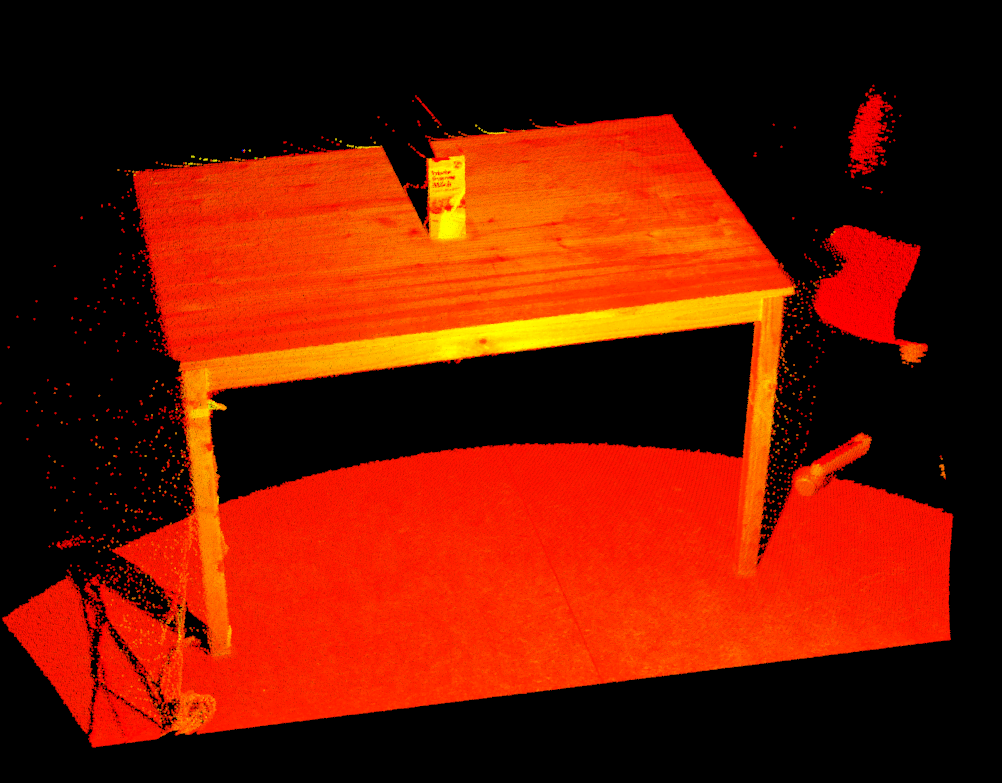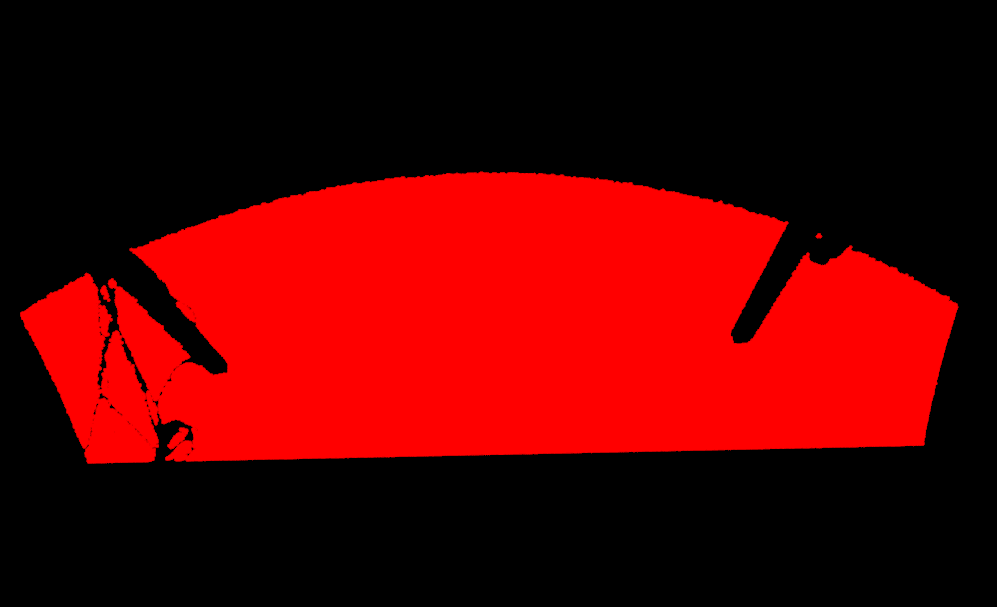桌子模型

下载:https://raw.github.com/PointCloudLibrary/data/master/tutorials/table_scene_lms400.pcd
代码
C++
#include <iostream>
#include <pcl/io/pcd_io.h>
#include <pcl/point_types.h>
#include <pcl/point_cloud.h>
#include <pcl/visualization/pcl_visualizer.h>
#include <pcl/filters/extract_indices.h>
#include <pcl/segmentation/sac_segmentation.h>
#include <vtkPoints.h>
#include <vtkPolyData.h>
#include <vtkActor.h>
#include <vtkRenderer.h>
#include <vtkRenderWindow.h>
#include <vtkPolyDataMapper.h>
#include <vtkInteractorStyle.h>
#include <vtkRenderWindowInteractor.h>
#include <vtkProperty.h>
#include <vtkCellArray.h>
#include <vtkInteractorStyleTrackballCamera.h>
VTK_MODULE_INIT(vtkRenderingOpenGL);
VTK_MODULE_INIT(vtkInteractionStyle);
// VTK绘制剩下的点云
void drawSegment(pcl::PointIndices &indices, pcl::PointCloud<pcl::PointXYZ>::Ptr cloud)
{
vtkSmartPointer<vtkPoints> points = vtkSmartPointer<vtkPoints>::New();
vtkSmartPointer<vtkCellArray> vertices = vtkSmartPointer<vtkCellArray>::New();
for (int i: (indices).indices) {
vtkIdType pid[1];
pid[0] = points->InsertNextPoint(cloud->at(i).x, cloud->at(i).y,
cloud->at(i).z);
vertices->InsertNextCell(1, pid);
}
vtkPolyData *polyData = vtkPolyData::New();
polyData->SetPoints(points);
polyData->SetVerts(vertices);
vtkPolyDataMapper *mapper = vtkPolyDataMapper::New();
mapper->SetInputData(polyData);
vtkActor *actor = vtkActor::New();
actor->SetMapper(mapper);
actor->GetProperty()->SetColor(1.0, 0.0, 0.0);
actor->GetProperty()->SetPointSize(3);
vtkRenderer *renderer = vtkRenderer::New();
renderer->AddActor(actor);
renderer->SetBackground(.0, .0, .0);//set background
vtkRenderWindow *renderwind = vtkRenderWindow::New();
renderwind->AddRenderer(renderer);
vtkInteractorStyleTrackballCamera *style = vtkInteractorStyleTrackballCamera::New();
vtkRenderWindowInteractor *renderwindIt = vtkRenderWindowInteractor::New();
renderwindIt->SetRenderWindow(renderwind);
renderwindIt->SetInteractorStyle(style);
renderwind->Render();
renderwindIt->Start();
}
int main()
{
pcl::PointCloud<pcl::PointXYZ>::Ptr cloud_source(new pcl::PointCloud<pcl::PointXYZ>);
std::string fileName = getenv("HOME") + std::string("/data_set/table_scene_lms400.pcd");
std::cout << fileName << std::endl;
pcl::io::loadPCDFile(fileName, *cloud_source);
// 模型系数
pcl::ModelCoefficients::Ptr coefficients(new pcl::ModelCoefficients);
// 点索引数组
pcl::PointIndices::Ptr inliers(new pcl::PointIndices);
pcl::SACSegmentation<pcl::PointXYZ> sac;
sac.setInputCloud(cloud_source);
// 提取方法
sac.setMethodType(pcl::SAC_RANSAC);
// 提取的物体模型
sac.setModelType(pcl::SACMODEL_PLANE);
sac.setDistanceThreshold(0.01);
sac.setMaxIterations(100);
sac.setProbability(0.95);
sac.segment(*inliers, *coefficients);
// 拟合系数
std::cout << *coefficients << std::endl;
// 绘制分割后的点云
drawSegment(*inliers, cloud_source);
}运行结果
header:
seq: 0 stamp: 0 frame_id:
values[]
values[0]: -0.00691321
values[1]: -0.875345
values[2]: -0.48345
values[3]: -1.17686

参考
https://pcl.readthedocs.io/projects/tutorials/en/master/planar_segmentation.html#planar-segmentation